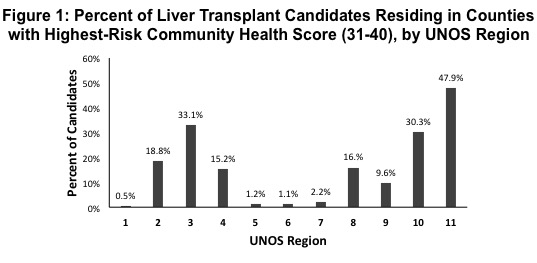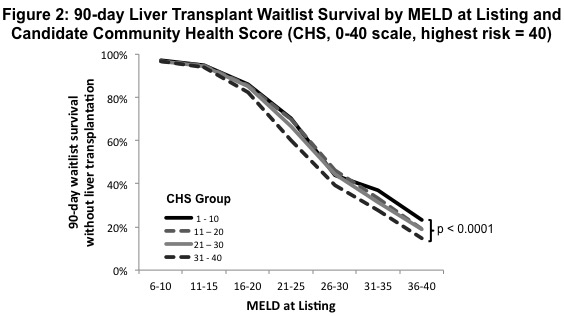Community Health, Center Proximity, and Liver Transplant Waitlist Mortality.
1Surgery, Emory University, Atlanta, GA
2Medicine, University of Pennsylvania, Philadelphia, PA
Meeting: 2017 American Transplant Congress
Abstract number: 387
Keywords: Allocation, Liver transplantation, Public policy, Waiting lists
Session Information
Session Time: 8:30am-9:15am
 Presentation Time: 8:30am-8:45am
Presentation Time: 8:30am-8:45am
Location: Arie Crown Theater
Background: While regional organ availability is frequently discussed in allocation policy, the impact of community-level factors and access to a transplant center on waitlist mortality remains poorly understood.
Methods: Data from the Scientific Registry of Transplant Recipients was used for retrospective review of all adult liver transplant candidates listed from 2002-2014. Candidate community health scores (CHS) were assigned using a previously published county-level metric integrating national data on health and economic risks (score 1-40; 40 = highest risk). Cox multivariable analysis was performed to assess impact of CHS and distance to listing center on waitlist mortality.
Results: Among 114,347 candidates, 22.1% resided in counties in the lowest quartile of CHS scores, while 15.7% lived in areas of highest risk. The distribution of patients in the highest-risk CHS group differed across UNOS regions (Figure 1). Median travel distance to listing center ranged from 15.5 miles (UNOS Region 9) to 75.3 miles (Region 11). 90-day waitlist mortality was inferior for candidates in high-risk counties (p < 0.0001 between CHS 1-10 and 31-40, Figure 2). In Cox modeling including demographics, MELD, liver disease etiology, travel distance, and UNOS region, residence in higher-CHS counties showed a stepwise increase in waitlist mortality (HR 1.07 (95% CI 1.03-1.11) for CHS 11-20, HR 1.11 (95% CI 1.07-1.15) for CHS 21-30, HR 1.16 (95% CI 1.10-1.21) for CHS 31-40). Travel distance >25 miles was associated with increased mortality (HR 1.05 (95% CI 1.01-1.10)). 
 Conclusions: Adverse local health and economic conditions and increased travel distance increase waitlist mortality. These risk factors are not uniform across UNOS regions, and reflect underlying disparities that should be addressed in future allocation policies.
Conclusions: Adverse local health and economic conditions and increased travel distance increase waitlist mortality. These risk factors are not uniform across UNOS regions, and reflect underlying disparities that should be addressed in future allocation policies.
CITATION INFORMATION: Lynch R, Ross K, Goldberg D, Patzer R. Community Health, Center Proximity, and Liver Transplant Waitlist Mortality. Am J Transplant. 2017;17 (suppl 3).
To cite this abstract in AMA style:
Lynch R, Ross K, Goldberg D, Patzer R. Community Health, Center Proximity, and Liver Transplant Waitlist Mortality. [abstract]. Am J Transplant. 2017; 17 (suppl 3). https://atcmeetingabstracts.com/abstract/community-health-center-proximity-and-liver-transplant-waitlist-mortality/. Accessed January 4, 2026.« Back to 2017 American Transplant Congress
